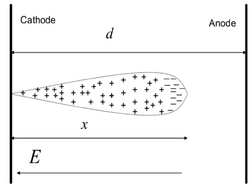Insulators under a high voltage
Introduction
Air is one of insulators that prevent charge exchange between two charged conductors. Parallel plates is an example where the air is insulating the negatively charged plate from he positively charged one. Nevertheless, air does keep this properties when the voltage difference between the plates causes air ionization. the process will produce free electrons accelerates toward the positive plate.Enough number of these electrons will make the air a conductor and sparking is observed on the plates.
Stages of Sparking
Sparking does not happen suddenly, but it microscopically has stages defined as the following:
- Avalanche formation
Physically is formulated using Townsend's primary ionization coefficient () that is defined as "The number of ionizing collisions that takes place during a unit length movement of one electron" (ref.1). A relationship is built combining the number of moving electrons (n) over a distance (dx) produce new free electrons (dn) as :
Solving the equation will give the number of the free electrons produced in a distance (x) as :
- Townsend discharges
Simultaneously happens with the first process, the gas ions will bombard the cathode, it will give energy to release new electrons. Townsend's secondary coefficient () is defined as "The number of electrons released at the cathode by the impact of one ion.
The impact will produce new electrons.
References
1- Dr JP Holtzhausen, Dr WL VoslooHigh "Voltage Engineering Practice and Theory" (online drift copy)
